Skiing Under the Lights
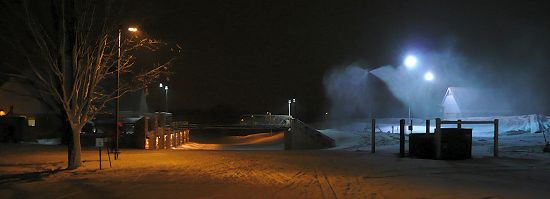
Keeping the lights on isn’t the hard part – getting them is.
Running three or four kilometers of lights at a cross country ski area typically costs about as much as it does to run an average three-bedroom Midwestern home – about $100 to $150 per month. On the other hand, high quality lighting can cost upwards of $80,000 per kilometer. This includes planning, buying and installing all of the poles, lights, wiring, junction boxes and any other necessary equipment.
Local skiers have undertaken the planning and funding of most trail lighting projects in the Midwest, but there are notable exceptions funded by tax dollars. The Three Rivers Park District lit five kilometers of trail at Hyland Lake Park with public money. According to Eric Nelson, senior manager of engineering for the Three Rivers Park District, the lighting equipment costs were about $240,000, and installing the light poles and wiring was about $245,000 for a total of $485,000. Annual operating costs are basically limited to the Xcel bill. That runs about $13,500/year but most of that energy goes to the snowmaking process. Park District funds and State Legacy grants funded this nearly half a million dollar project, as no private or county money was used.
The trail has snowmaking, so the engineers installed lights nine feet above ground so they would be six or seven feet above the deeper man-made snow. “The LED lights are aimed directionally up the trail and are very precise in their lighted footprint,” said Nelson. “Some portions of our trail are near residential areas, and light pollution was a major concern, but so far we have had no complaints related to lighting. The fixtures are also quite stout and resistant to tampering and vandalism.” Three Rivers used a product called Micro Flood (http://www.kimlighting.com/products/microflood) from Kim Lighting.
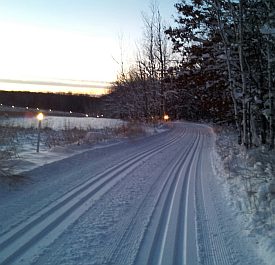
According to Pete Theismann, Stearns County Park Director, park officials and skiers wanted to maintain as much as possible the wilderness quality of Quarry Park and Nature Preserve. “We did look at overhead lights and thought they would make the park like a big box store parking lot, said Theismann. Most of the 265 lights are 85’ apart, but where the trail runs through the prairie the lights are spaced 150’ apart.
Eastwood Golf Course in Rochester, Minn. uses a portable system similar to Quarry Park, thanks to the efforts of the Rochester Area Sports Club. Installed 12 years ago on three kilometers of trail, the lights cost $80,000 with the money coming from a combination of federal, state and city grants. The city covers all of the minimal operating costs. Eastwood’s lights sit on four-foot poles around the course, which like Quarry Park’s, makes the globes and bulbs easy to vandalize.
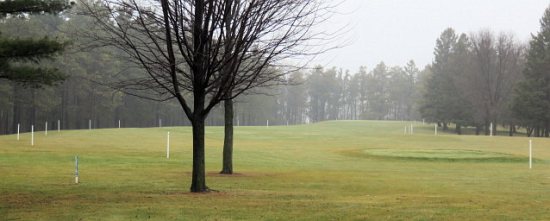
Since the lights are situated on a golf course, they must be set up and removed each year. “We have a fantastic group of skiers and volunteers in Rochester, but it does become a chore to manage the lighting install/removal since the golfers are always itching to golf before we have time to remove the lights,” said Henry Walker of the Rochester Area Sports Club. After the snow melts and the ground is wet, RASC can’t drive on the course and must walk along with a cart to collect the light poles.
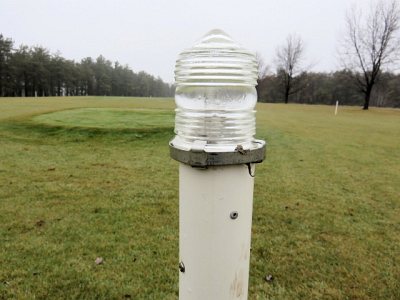
Other clubs have used private money and local labor to get their lighting. The Wausau Nordic Ski Club installed lights in 2000 on 6.3 km of county forest trail at Nine Mile for $150,000, which the club planned, installed and funded with donations from local skiers and businesses. This is over $200,000 in today’s dollars, a significant investment, but one reaping immediate and dramatic results.
It’s no surprise the rise of ski programs at Nine Mile coincided with the lights. Before the lights at Nine Mile, it was rare to see a car in the parking lot after dark; with the lights, as many as 60 cars fill the lot on weekday nights, especially on nights with scheduled youth ski programs. In fact, the Wausau Nordic Ski Club’s junior high ski program, run by Greg and Rachel Kresse, is called the Night Gliders because practice starts at 5:30 p.m, which for much of the ski season is dark.
Minocqua Winter Park has had lights on the 2.2 km of their Base Loop since the mid-80s when members of the Lakeland Touring Ski Club decided they wanted to ski at night. MWP’s website described this system as “pieced together with a rag tag collection of floodlights, short posts, and old wire.” According to Tim Collins, current director of MWP the trenches were “hand-dug, sometimes not very deep.” And the lights themselves were “telephone poles with basic big glass lamps, just like the amber/peach-colored lights you'd find on an old street.”
In 2012, MWP started a project to modernize these nearly 30-year-old lights. Collins stated that once section of lights “had lots of frost damage.” The new system uses two LED flood lights mounted to 4”X4” posts 12” above ground. “We used a real trencher for that job.” Most of the recent funding has come from Lakeland members when the club sold individual poles for $500 and placed a plaque commemorating the sale on the pole. Collins dreams of installing solar lights in the future, which would eliminate the trenching and wiring between poles.
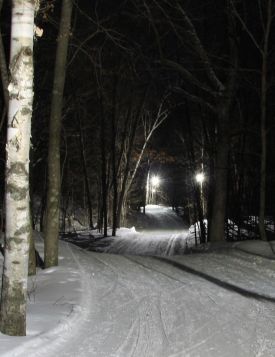
Don Maher, a former ABSF board member and professional electrician, strung the initial 30 high pressure sodium overhead lights on 1.5 km of trail, the lights stopping just beyond the Wall south of the 24 km marker. In fact, when the snow was fast, skis would outrun the lights down the Wall, plunging skiers into darkness.
In the fall of 2005, the ABSF and Sawyer County lit two more trails at OO – one east of what’s now the Birkie skate trail and one west of the trail, creating a total of five kilometers of nighttime skiing. About 100 lights are strung along the five total kilometers, and all totaled the lights cost about $300 per season to operate.
The Birkie also lights three kilometers of trail at the Fish Hatchery trailhead a few miles northeast of Hayward. These overhead lights went up in 1999, according to Ben Popp, director of the American Birkebeiner.
The Bay Nordic Ski Club will add lights on four kilometers of trail at the Reforestration Camp the 2015-2016 season. The ski club has partnered with Brown County for the $250,000 project, which will be funded by public and corporate donations.
Lights can’t add days to the ski season, but they do add ski hours to each day, particularly at the dark end of the work and school day. They’re well worth the time, effort and money invested.
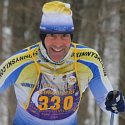 | About the author... Former member of the Skinnyski.com Race team, Mark Parman lives in Wausau, Wis. and has skied 23 Birkies. He writes mostly about outdoor sports and has written for Sports Afield, Dirt Rag, Bicycle Times, Velonews and Silent Sports. |

